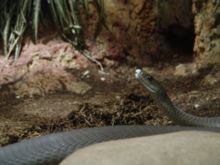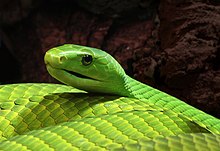Mamba
| Dendroaspis | |
|---|---|

| |
| Black mamba | |
| Scientific classification | |
| Kingdom: | |
| Phylum: | |
| Subphylum: | |
| Class: | |
| Order: | |
| Suborder: | |
| Family: | |
| Genus: | Dendroaspis |
| Species | |
Dendroaspis (literally "tree asp"), commonly referred to as Mamba, is a genus of family Elapidae which comprises four species, all of which are highly venomous, fast-moving land-dwelling snakes of Africa. They are feared throughout their ranges, especially the black mamba. In Africa, there are many legends and stories describing these snakes.[2]
Behavior
Most of the members of this genus (for example green mambas) are arboreal. However, the black mamba is terrestrial. They are diurnal: during the day, they actively hunt their prey of small mammals, birds, and lizards, and return to the same lair nightly.
Mambas are related to the cobras (Elapidae); their threat display, when they stretch a slightly smaller "hood" while gaping their mouth, is similar.
Many people believe that the black mamba will chase and attack humans. However, this is probably misunderstood because of the speed with which this species can move.[3] The black mamba usually uses its speed to escape from threats. Humans are actually their main predators, rather than their prey.[2] They generally avoid contact with humans.[4]
Venom

All mambas are highly venomous. Their venoms consist mostly of neurotoxins (known as dendrotoxins). Besides the neurotoxins, they also carry cardiotoxins[5][2] and fasciculins. Other components may include calcicludine, which is a known component of the eastern green mamba's venom and calciseptine, which is a component of black mamba venom. Toxicity of individual specimens within the same species and subspecies can vary greatly based on several factors, including geographical region. Even the weather and altitude can influence toxicity (Ernst and Zug et al. 1996). A bite can be fatal to humans without access to proper first aid and subsequent antivenom treatment, as it shuts down the lungs and heart. The western green mamba (D. viridis), eastern green mamba (D. angusticeps), and Jameson's mamba (D. jamesoni) possess venom similar in composition and effects to that of the black mamba's (D. polylepis). However, as their venoms are less toxic (based upon LD50 studies), their temperaments are generally not as aggressive or as explosive when provoked, and none of the three inject as much venom as the black mamba, their bites are materially less dangerous.[citation needed]
Prior to the availability of antivenom, envenomations by members of this genus carried a high fatality rate. An untreated black mamba bite has a mortality rate of 100%,[4][6] but presently, fatalities have become much rarer due to wide availability of antivenom.
Mamba toxins
Mamba toxin (or dendrotoxin) consists of several components, with different targets. Examples are:
- Dendrotoxin 1, which inhibits the K+ channels at the pre and post-synaptic level in the intestinal smooth muscle. It also inhibits Ca2+-sensitive K+ channels from rat skeletal muscle‚ incorporated into planar bilayers (Kd = 90 nM in 50 mM KCl).[7])
- Dendrotoxin 3, which inhibits acetylcholine M4 receptors.[8]
- Dendrotoxin 7, commonly referred to as muscarinic toxin 7 (MT7) inhibits acetylcholine M1 receptors.[8]
- Dendrotoxin K, structurally homologous to Kunitz-type proteinase inhibitors [9] with activity as a selective blocker of voltage-gated potassium channels [10]
Species
- There are currently three species of green mamba and one black mamba. The word "black" is describing the colour of the serpent's mouth instead of its brown or grey body.
* Including the nominate subspecies.
T Type species.
References
- ^ "Dendroaspis". Integrated Taxonomic Information System. Retrieved 30 October 2012.
- ^ a b c "National Geographic (Black Mamba, Dendroaspis polylepis)". National Geographic Society. Retrieved 05-07-2013.
African myths exaggerate their capabilities to legendary proportions; Black mambas are shy and will almost always seek to escape when confronted.
{{cite web}}: Check date values in:|accessdate=(help) - ^ The new encyclopedia of Reptiles (Serpent). Time Book Ltd. 2002.
- ^ a b O'Shea, Mark (2005). VENOMOUS SNAKES OF THE WORLD. multiple places: US and Canada: Princeton University Press; Europe: New Holland (UK) Ltd. p. 78-79. ISBN 978-0-691-15023-9.
...in common with other snakes they prefer to avoid contact;...Of the three species of green mambas...;...from 1957 to 1963...including all seven black mamba bites - a 100 per cent fatality rate
- ^ "Putative cardiotoxicity of the venoms of three mamba species". Journal of Wilderness and Environmental Medicine. 7 (2): 115–21. May 1996. PMID 11990104.
{{cite journal}}: Unknown parameter|authors=ignored (help)CS1 maint: year (link) - ^ Davidson, Terence. "IMMEDIATE FIRST AID". University of California, San Diego. Retrieved 2011-09-22.
- ^ "[Potassium channels and epilepsy: evidence that the epileptogenic toxin, dendrotoxin, binds to potassium channel proteins.]". Epilepsy Research Supplement. 4: 263–73. 1991. PMID 1815606.
{{cite journal}}: Unknown parameter|authors=ignored (help) - ^ a b Rang, H. P. (2003). Pharmacology. Edinburgh: Churchill Livingstone. p. 139. ISBN 0-443-07145-4.
- ^ "[Nuclear magnetic resonance solution structure of dendrotoxin K from the venom of Dendroaspis polylepis polylepis.]". Journal of Molecular Biology. 234 (3): 735–50. 1993. doi:10.1006/jmbi.1993.1623. PMID 8254670.
{{cite journal}}: Unknown parameter|authors=ignored (help); Unknown parameter|month=ignored (help) - ^ "Dendrotoxins: structure-activity relationships and effects on potassium ion channels". Curr Med Chem. 23: 3065–72. 2004. doi:10.2174/0929867043363820. PMID 15579000.
{{cite journal}}: Unknown parameter|authors=ignored (help) - ^ a b c "Dendroaspis". Integrated Taxonomic Information System. Retrieved 05-07-2013.
{{cite web}}: Check date values in:|accessdate=(help)
